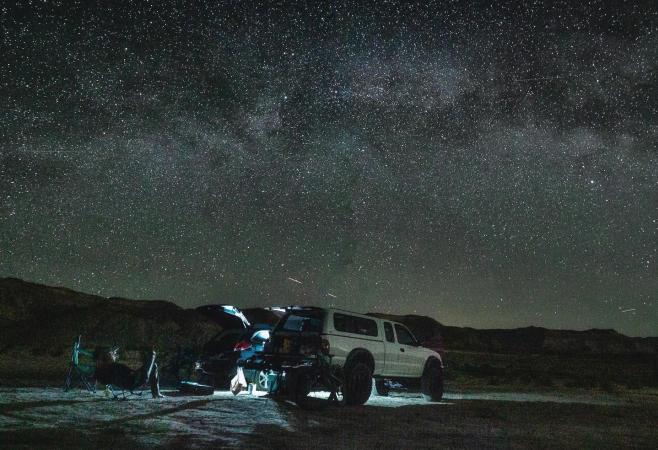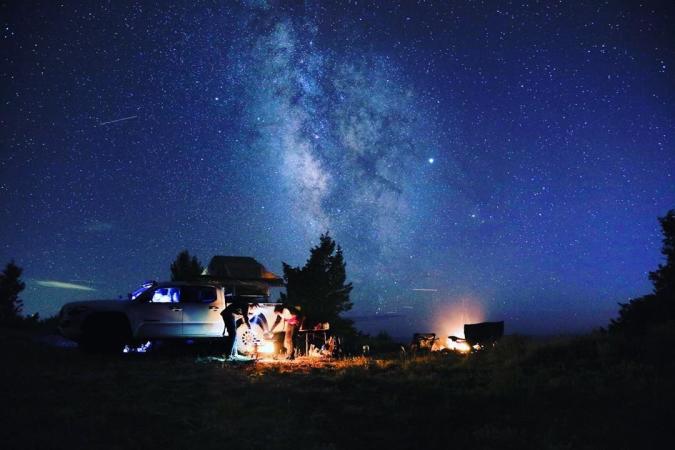Winter nights in Grand Junction offer a wide range of stargazing experiences. The crisp, clear air creates the perfect canvas for the stars to shine their brightest, painting the night sky with breathtaking clarity. Winter’s stunning constellations step into the spotlight—Orion’s Belt, the Pleiades, and Gemini’s twins twinkle brilliantly against the black sky. Plus, longer nights mean more time to enjoy the celestial show. So bundle up with a hot drink and some blankets, and prepare to be entertained during an evening of nature's light show.
The real trick to seeing stars shine is escaping the light pollution. While Grand Junction might be the biggest city between Denver and Salt Lake, it is also home to some of the darkest skies in Colorado, making it the perfect place to see the constellations without giving up the big city amenities.
Here are a few of the best places around Grand Junction to catch a glimpse of the universe. Some of these spots are easy to get to, some require a little walking and others are more challenging to reach, but all offer an unbelievable reward.
Colorado National Monument:
Just ten minutes from Downtown Grand Junction is the Colorado National Monument, a 20,500-acre labyrinth of canyons, cliffs, and spires. It’s hard to believe such an alien-looking landscape exists only ten minutes from town. When the city lights fade away into the distance, the landscape appears even more extraterrestrial, backlit by a blanket of stars.
Both Monument Canyon and Wedding Canyon are filled with impressive rock spires reaching more than 450 feet into the air. Book Cliff View, Grand View, and Otto’s Trail are all picturesque spots to spread out a blanket or two and watch the sky unfold above. You can drive to Book Cliff View and Grand View or hike on Otto’s Trail, which is about a quarter-mile from the parking area. Make sure you bring a flashlight and plenty of warm clothes!
Don't just watch the stars for a few hours—spend the whole night and camp under them! Saddlehorn Campground in Colorado National Monument is perfect for an overnight excursion. Campsites at A Loop are available year-round, while sites in B Loop are open mid-March through October and reservations are required.
Miracle Rock:
While the Colorado National Monument has plenty of locations to stargaze from, Miracle Rock is a one-of-a-kind stargazing destination. Located in Glade Park behind Colorado National Monument, a 12,000-ton boulder sits upright at the end of a ridgeline cliff, perfectly balanced on a beam that, in places, is no wider than 4 inches. Standing over 84 feet tall, this giant rock resembles a potato, but at night, it takes on a life of its own.
During the day, Miracle Rock will spark your imagination as you try to figure out how Mother Nature managed to wrangle such a massive boulder into such a precarious position. The night sky only intensifies the mystery. Witnessing the bright belt of the constellations arc over a 24,000,000-pound potato is about as otherworldly as it gets.
While it’s about a 40-minute drive from Grand Junction to the Miracle Rock parking lot (albeit a gorgeous drive with breathtaking overlooks), the hike to the actual rock is only a half mile. With a flashlight, the trail is easy to navigate. As you approach Miracle Rock, be cautious and watch your step. If you choose to camp in the area, be sure to adhere to the Bureau of Land Management’s guidelines for dispersed camping.
The Ribbon:
Lovingly called Moon Rock by some locals, this big flat rock will make you feel like you’re walking on the moon. While the Ribbon Trail is a popular mountain bike trail known for its steep descents and technical features, it’s an easy half-mile hike from the upper trailhead to this big moon-like surface.
To reach the upper trailhead, drive up Little Park Road about eight miles until you see a sign for the Ribbon on your right. Park in the lot and head down the trail about a half mile until you find the giant white rock. This moon-like surface extends up above the surrounding landscape, coupled with steep drops on all sides - it feels as though you’re actually on the moon, adrift in space. With 360-degree panoramic views, the majesty of the sky will envelop you. The only thing anchoring you to Earth is the dim sparkle of the city lights off in the distance. This is also a popular spot on the 4th of July, where all the fireworks in the entire town can be seen from one vantage point.
Rattlesnake Arches:
The most difficult to reach but offering the potential for the most stunning rewards is Rattlesnake Arches in McInnis Canyons National Conservation Area. There are two routes available which are mapped out here for easy reference. The difficult 15.5-mile roundtrip hike, via Pollock Bench Trailhead, requires preparation and experience. If you prefer a route with less hiking, you can take the Upper Trailhead via Glade Park to the Rattlesnake Arches Upper Trailhead. However, this route requires a high-clearance 4-wheel drive vehicle and is closed from February 15 through April 15. The trail will need to be dry or frozen to drive on it, especially if you are visiting in the winter.
If you make the 15.5-mile trek or drive to the Upper Trailhead, you’ll discover the world's second-largest concentration of natural arches, second to Arches National Park in Moab. These giant free-standing arches, land bridges and windows create striking vantages to the celestial bodies above. For a more detailed look into how to explore this unique and remote area, check out the Rattlesnake Arches blog post.
If you plan on starting the trip in the day and camping out overnight, it’s important to note that camping is not allowed within a quarter mile of the Rattlesnake Arches loop, along the access roads on the Upper Trailhead route and at the trailhead. As long as you follow these restrictions and camp on a durable surface like packed dirt or rock (not vegetation), you are free to find your perfect site. Be sure to adhere to BLM dispersed camping guidelines and current fire restrictions, and Do Grand Junction Right to help make sure places like this stay pristine for everyone.
Always be prepared and know before you go. If you have never been to a particular location, arrive early to avoid hiking after nightfall or go a day in advance to scout locations, trails and potential hazards. Check the weather, dress accordingly and bring layers along with plenty of water and food. Seeing the night sky bursting with stars is an incredible experience that is very grounding and will shine bright in your memories for years to come.
For more ways to experience Grand Junction, check out the Official Grand Junction Visitor Guide!








